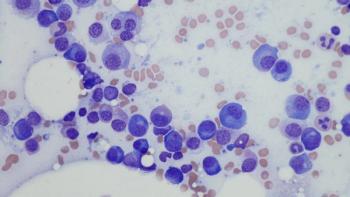
Multiple Myeloma Treatments: Quality-of-Life Considerations
Transcript:
C. Ola Landgren, MD: I think it’s important for me to bring up—and I told you this, many times—that there is no particular number that needs to prompt therapy. It is really kind of a judgment call. Given that you had a lot of disease at diagnosis, I told you that we shouldn’t wait until it kind of comes back again. I felt that it would be better to be a little bit more proactive. But all of your other labs were fine. Your kidney function was fine. You had no anemia. You had no symptoms.
Aurora Torres: Yes, correct.
C. Ola Landgren, MD: I told you that we could do oral therapy, or intravenous therapy, or a combination. You said that you wanted to do oral therapy.
Aurora Torres: Right.
C. Ola Landgren, MD: So, we started you on ixazomib, with lenalidomide and dexamethasone. What was your experience with that?
Aurora Torres: Well, it was not good. I was very fatigued. I was not functional. I couldn’t get out of bed to do anything. I didn’t feel that it was offering me a good quality of life, so I told you that I didn’t think I could continue on it. It was so negative for me.
C. Ola Landgren, MD: You did a first cycle for 4 weeks. Did you have these symptoms right away?
Aurora Torres: Yes.
C. Ola Landgren, MD: We discussed everything, and you said, “Let’s try another cycle.” I thought that was reasonable.
Aurora Torres: Right.
C. Ola Landgren, MD: And then, you said, “I cannot do this.”
Aurora Torres: I couldn’t do it anymore. It was too detrimental for me. I could not move. I could not function. I would get up and have breakfast. Then I’d have to go back to bed because there was nothing else that I could do. The fatigue was just overwhelming.
C. Ola Landgren, MD: You said you had nausea, also?
Aurora Torres: Yes. I had nausea from that, too.
C. Ola Landgren, MD: And diarrhea?
Aurora Torres: No, no diarrhea.
C. Ola Landgren, MD: But the nausea was there?
Aurora Torres: Yes.
C. Ola Landgren, MD: Did you have any rash?
Aurora Torres: No, no rash.
C. Ola Landgren, MD: The reason that we had picked that regimen, when we discussed whether you should do an intravenous or oral therapy, was because the oral therapy sounded like a more convenient regimen.
Aurora Torres: Right.
C. Ola Landgren, MD: It turned out that the toxicity profile just did not really work.
Aurora Torres: No, it did not agree with me.
C. Ola Landgren, MD: Then, we had to think about something else. We will talk about that in a little bit.
Aurora Torres: OK.
C. Ola Landgren, MD: The reason you chose the oral regimen was because of convenience. You didn’t have to come in for infusions. I have treated many patients, for many years, and I have noticed that depending on how the options are being presented, people choose different things.
If the doctor asks, “You have oral versus intravenous therapy, what would you choose?” most people would choose oral because it sounds better. If the doctor says, “We have a more efficacious regimen that, unfortunately, is given intravenously” and you then reveal the oral therapy, focusing on convenience, many people would pick the more efficacious treatment, even if it’s more inconvenient. I’m not saying that intravenous, in this particular case, was necessarily very different from the oral option. In your case, it could go either way. Both of these options, that we talked about, were quite equivalent. But many times, in a broader context, I have noticed that the way these things are being communicated impacts what patients feel is the right thing to do, in terms of the choice. And if they choose the more convenient option and it doesn’t work, they still end up receiving the other therapy. I think that’s an important component when it comes to the delivery of the information.
Transcript Edited for Clarity



